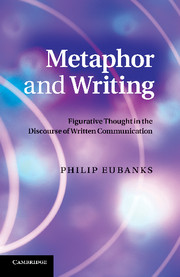Book contents
- Frontmatter
- Contents
- List of figures
- List of tables
- Acknowledgements
- Introduction
- 1 In search of the figurative rhetoric of writing
- 2 The double bind of writer and to write: Graded categories
- 3 Bind upon bind: The general-ability and the specific-expertise views of writing
- 4 Three licensing stories: The literate inscriber, the good writer, and the author writer
- 5 Writing as transcription, talk, and voice: A complex metonymy
- 6 The writing self: Conceptual blends, multiple selves
- 7 Writing to “get ideas across”: The role of the Conduit Metaphor
- 8 Codes and conversations: The other Conduit Metaphor
- 9 Metaphor and choice
- References
- Index
8 - Codes and conversations: The other Conduit Metaphor
Published online by Cambridge University Press: 06 December 2010
- Frontmatter
- Contents
- List of figures
- List of tables
- Acknowledgements
- Introduction
- 1 In search of the figurative rhetoric of writing
- 2 The double bind of writer and to write: Graded categories
- 3 Bind upon bind: The general-ability and the specific-expertise views of writing
- 4 Three licensing stories: The literate inscriber, the good writer, and the author writer
- 5 Writing as transcription, talk, and voice: A complex metonymy
- 6 The writing self: Conceptual blends, multiple selves
- 7 Writing to “get ideas across”: The role of the Conduit Metaphor
- 8 Codes and conversations: The other Conduit Metaphor
- 9 Metaphor and choice
- References
- Index
Summary
In Criticks hands, beware thou dost not come;
And take thy way where yet thou art not known,
If for thy Father askt, say, thou hadst none:
And for thy Mother, she alas is poor,
Which caus'd her thus to send thee out of door.
Anne Bradstreet, “The author to her book”I argued in the previous chapter that we cannot make sense of the Conduit Metaphor unless we consider the metaphors that are closely related to it, most evidently Language Is Power. But that is only the beginning. We also need to ask: What stories license the Conduit Metaphor? And – just as important – what imaginative achievements would we sacrifice if we did not have the Conduit Metaphor?
The Conduit Metaphor has been denounced by scholars, in large part, because it has been associated with a story of writing and communication that certainly deserves to be criticized. It is a story of “good writing” in its narrowest conception: writing that flows in one direction only, from writer to readership, and is associated predominantly with values such as factual and grammatical correctness, precision, detachment, and objectivity. That narrow good-writer story ignores what makes many of us value most about writing: the possibility that writing can engage a reader – intellectually, emotionally, spiritually. In short, it is a story of impersonal skill rather than of rhetorical sensitivity.
- Type
- Chapter
- Information
- Metaphor and WritingFigurative Thought in the Discourse of Written Communication, pp. 170 - 193Publisher: Cambridge University PressPrint publication year: 2010

